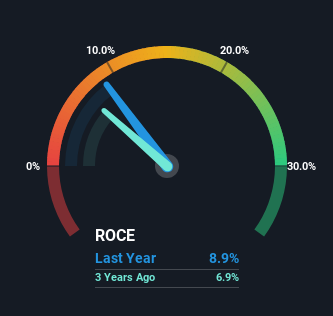- Japan
- /
- Trade Distributors
- /
- TSE:9830
Trusco Nakayama (TSE:9830) Hasn't Managed To Accelerate Its Returns

If you're not sure where to start when looking for the next multi-bagger, there are a few key trends you should keep an eye out for. In a perfect world, we'd like to see a company investing more capital into its business and ideally the returns earned from that capital are also increasing. Put simply, these types of businesses are compounding machines, meaning they are continually reinvesting their earnings at ever-higher rates of return. However, after investigating Trusco Nakayama (TSE:9830), we don't think it's current trends fit the mold of a multi-bagger.
What Is Return On Capital Employed (ROCE)?
For those that aren't sure what ROCE is, it measures the amount of pre-tax profits a company can generate from the capital employed in its business. Analysts use this formula to calculate it for Trusco Nakayama:
Return on Capital Employed = Earnings Before Interest and Tax (EBIT) ÷ (Total Assets - Current Liabilities)
0.089 = JP¥19b ÷ (JP¥254b - JP¥40b) (Based on the trailing twelve months to June 2024).
Therefore, Trusco Nakayama has an ROCE of 8.9%. On its own that's a low return, but compared to the average of 7.4% generated by the Trade Distributors industry, it's much better.
See our latest analysis for Trusco Nakayama

Above you can see how the current ROCE for Trusco Nakayama compares to its prior returns on capital, but there's only so much you can tell from the past. If you're interested, you can view the analysts predictions in our free analyst report for Trusco Nakayama .
So How Is Trusco Nakayama's ROCE Trending?
In terms of Trusco Nakayama's historical ROCE trend, it doesn't exactly demand attention. Over the past five years, ROCE has remained relatively flat at around 8.9% and the business has deployed 45% more capital into its operations. This poor ROCE doesn't inspire confidence right now, and with the increase in capital employed, it's evident that the business isn't deploying the funds into high return investments.
In Conclusion...
In summary, Trusco Nakayama has simply been reinvesting capital and generating the same low rate of return as before. Additionally, the stock's total return to shareholders over the last five years has been flat, which isn't too surprising. Therefore based on the analysis done in this article, we don't think Trusco Nakayama has the makings of a multi-bagger.
If you want to continue researching Trusco Nakayama, you might be interested to know about the 1 warning sign that our analysis has discovered.
For those who like to invest in solid companies, check out this free list of companies with solid balance sheets and high returns on equity.
Valuation is complex, but we're here to simplify it.
Discover if Trusco Nakayama might be undervalued or overvalued with our detailed analysis, featuring fair value estimates, potential risks, dividends, insider trades, and its financial condition.
Access Free AnalysisHave feedback on this article? Concerned about the content? Get in touch with us directly. Alternatively, email editorial-team (at) simplywallst.com.
This article by Simply Wall St is general in nature. We provide commentary based on historical data and analyst forecasts only using an unbiased methodology and our articles are not intended to be financial advice. It does not constitute a recommendation to buy or sell any stock, and does not take account of your objectives, or your financial situation. We aim to bring you long-term focused analysis driven by fundamental data. Note that our analysis may not factor in the latest price-sensitive company announcements or qualitative material. Simply Wall St has no position in any stocks mentioned.
About TSE:9830
Trusco Nakayama
Engages in the wholesale of machine tools, and other equipment in Japan and internationally.
Solid track record with adequate balance sheet.
Market Insights
Community Narratives



